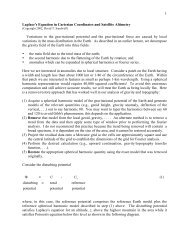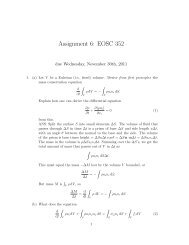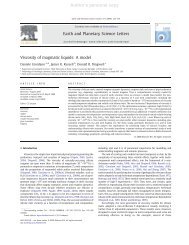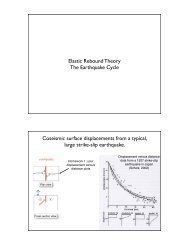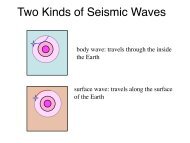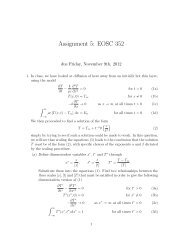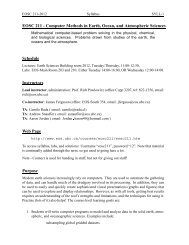Igneous petrology EOSC 321 Laboratory 2: Mafic and intermediate ...
Igneous petrology EOSC 321 Laboratory 2: Mafic and intermediate ...
Igneous petrology EOSC 321 Laboratory 2: Mafic and intermediate ...
Create successful ePaper yourself
Turn your PDF publications into a flip-book with our unique Google optimized e-Paper software.
<strong>Igneous</strong> <strong>petrology</strong> <strong>EOSC</strong> <strong>321</strong><br />
<strong>Laboratory</strong> 2:<br />
<strong>Mafic</strong> <strong>and</strong> <strong>intermediate</strong> plutonic rocks<br />
Material Needed: a) Microscope, b) Classification triangles <strong>and</strong> instructions on<br />
determination of plagioclase composition included with lab h<strong>and</strong>out; d) a Manual on<br />
Optical Mineralogy (i.e. Minerals in Thin Section by Perkins <strong>and</strong> Henke)<br />
Lab Organization: You will receive a thin section of an unknown ultramafic rock for your<br />
independent 1h-examination. Write its petrographic description using descriptions of<br />
reference thin sections as a template <strong>and</strong> give a rock name. Your petrographic report<br />
should be completed <strong>and</strong> h<strong>and</strong>ed to the TA by the end of the first hour of your Lab. The<br />
marked assignment will be returned to you in the next Lab.<br />
The remaining two hours of the Lab will be devoted to new material – thin<br />
sections of mafic <strong>and</strong> <strong>intermediate</strong> plutonic rocks. First you will practice optical<br />
determination of plagioclase composition. Then, after this skill is mastered, you will<br />
examine reference thin sections of mafic-<strong>intermediate</strong> rocks. Each thin section has a brief<br />
petrographic description to assist you in the identification of minerals, textures <strong>and</strong> rock<br />
classification. Please make sure you underst<strong>and</strong> the reference petrographic descriptions<br />
<strong>and</strong> can find all minerals mentioned. You should also be able to underst<strong>and</strong> why a rock is<br />
given a particular name. Look through thin sections of different rock types so that by the<br />
end of the Lab you will have examined all of them. Many thin sections demonstrate the<br />
same rock type, but you do not have to see all ~20 thin sections.<br />
Introduction: This lab introduces mafic <strong>and</strong> <strong>intermediate</strong> plutonic rocks <strong>and</strong> teaches you<br />
how to determine plagioclase composition in a thin section. The importance of this<br />
petrographic skill cannot be overestimated. The very classification of rocks depends on<br />
the correct determination of the composition of plagioclase. A clinopyroxene-plagioclase<br />
rock could be called gabbro if the plagioclase is Ca-rich or diorite if the plagioclase is<br />
more sodic (i.e. <strong>and</strong>esine).<br />
<strong>Mafic</strong> rocks consist mainly of clinopyroxene <strong>and</strong> plagioclase (labradorite) with accessory<br />
orthopyroxene, olivine, hornblende <strong>and</strong> biotite. Typical alteration products of these<br />
primary phases are chlorite, sericite (fine-grained muscovite), talc, serpentine, amphibole<br />
<strong>and</strong> mica. <strong>Mafic</strong> plutonic rocks include gabbro, norite, troctolite, anorthosite, <strong>and</strong><br />
diabase. Diabase is the North American name used for medium-grained basic rocks<br />
(grains 1-3 mm) consisting essentially of labradorite, augite <strong>and</strong> ore minerals, i.e.<br />
equivalent of basalt <strong>and</strong> gabbro. The rest of the world uses the term Dolerite in<br />
preference to Diabase to denote the same rock. Diabase has smaller grains than other<br />
plutonic mafic rocks <strong>and</strong> often is formed in a hypabyssal environment.<br />
A most abundant <strong>intermediate</strong> plutonic rock is diorite. This is a coarse-grained<br />
rock consisting of <strong>and</strong>esine plagioclase <strong>and</strong> one or more mafic minerals clino-<strong>and</strong> ortho-
pyroxene, hornblende, <strong>and</strong> biotite. A little quartz, K-feldspar <strong>and</strong> olivine may be present.<br />
Diorite is a coarse-grained equivalent of <strong>and</strong>esite.<br />
Lab2-2011.doc <strong>Igneous</strong> Petrology <strong>EOSC</strong> <strong>321</strong> Lab<br />
2
Reference collection: <strong>Mafic</strong> <strong>and</strong> <strong>intermediate</strong> plutonic rocks<br />
Thin Section: 1367 1<br />
Sample: P 939<br />
Rock Type: Pyroxene Hornblende Gabbronorite<br />
Location: Ruskin Dam, W.H.M<br />
Thin Section Description:<br />
Texture: Hypidiomorphic<br />
60% Plagioclase. Euhedral to subhedral shapes, An60 , but zoned!<br />
15% Orthopyroxene. Euhedral to subhedral shapes. Shows lamellae. Low<br />
birefringence, parallel extinction. Rimmed by late amphibole<br />
5% Clinopyroxene. Euhedral to subhedral shapes, inclined extinction.<br />
Rimmed by late amphibole<br />
10% Amphibole, pleochroic from darker to lighter green (Hornblende?)<br />
2% Opaque mineral, anhedral<br />
Comments: Amphibole is late magmatic (deuteric?) or secondary<br />
Thin Section: 1349 2<br />
Sample: P 1241<br />
Rock Type: Olivine gabbronorite<br />
Location:<br />
Thin Section Description:<br />
Texture: Subophitic. This texture is typical of mafic intrusive rocks. It is created<br />
by elongate chadacrysts partly enclosed by the oikocryst. In gabbros<br />
chadacrysts of plagioclase are partly enclosed by oikocrysts of pyroxene<br />
<strong>and</strong> olivine.<br />
70% Plagioclase, euhedral to subhedral. Combined Carlsbad-Albite twins give<br />
extinction angles of 20 <strong>and</strong> 31 => An61<br />
15% Clinopyroxene. Anhedral<br />
8% Olivine in subhedral grains now almost totally replaced by a secondary<br />
aggregate of serpentine, fine-grained black opaque hematite <strong>and</strong> talc.<br />
4% Orthopyroxene. Anhedral to subhedral shapes. Slightly pleochroic<br />
1% Opaque mineral, anhedral<br />
Lab2-2011.doc <strong>Igneous</strong> Petrology <strong>EOSC</strong> <strong>321</strong> Lab<br />
3
Lab2-2011.doc <strong>Igneous</strong> Petrology <strong>EOSC</strong> <strong>321</strong> Lab<br />
4<br />
Thin Section: 1689, 1685 (2 T/s), 1690 3, 4, 5, 6<br />
Sample: P 2720, feeder plug, P2716, P2112<br />
Rock Type: Olivine gabbro<br />
Location: Bonaparte Area<br />
Thin Section Description:<br />
Texture: Ophitic. This texture is typical of mafic intrusive rocks. It is created by<br />
elongate chadacrysts enclosed by the oikocryst. In gabbros chadacrysts of<br />
plagioclase are partly enclosed by oikocrysts of pyroxene <strong>and</strong> olivine.<br />
83% Plagioclase, euhedral to subhedral.<br />
10% Olivine, euhedral . Can be recognized by the extinction parallel to the<br />
elongation, <strong>and</strong> the absence of cleavage.<br />
7% Clinopyroxene. Smaller grains, anhedral to subhedral, grey-greenish in<br />
colour, with cleavage.<br />
1% Opaque mineral, anhedral to euhedral<br />
traces of apatite – in small euhedral grains with hexagonal cross-sections <strong>and</strong> very<br />
low birefringence.<br />
Thin Section: 1173 7<br />
Sample: P722<br />
Caution: Thin section is thicker than normal <strong>and</strong> plagioclases appear yellow in cross<br />
polarized light!<br />
Rock Type: Anorthosite<br />
Location: Troodos, Cyprus<br />
Thin Section Description:<br />
Texture: Allotriomorphic: all minerals are anhedral<br />
96% Plagioclase, anhedral to subhedral<br />
3% Olivine, anhedral, interstitial<br />
1% Amphibole, forms rims on olivine, pleochroic from light to dark green,<br />
cleavage at 60 o (hornblende?)<br />
few grains of black opaque minerals<br />
Secondary Minerals: Epidote or clinozoisite, characterized by moderate relief,<br />
anomalous blue interference colour <strong>and</strong> twinning. Found in large auhedral<br />
elongate laths, after Plag or Px?<br />
Thin Section: 1217 8<br />
Sample: P752<br />
Rock Type: Fine-grained diorite<br />
Location: ?<br />
Thin Section Description:<br />
Texture: Ophitic<br />
73% Plagioclase- Euhedral, ~An42. based on albite twins.<br />
10% Clinopyroxene, grey, from subhedral to anhedral, often twinned.<br />
7% Opaque mineral or minerals. Some grains are euhedral elongate<br />
(Ilmenite?), some are anhedral.
Lab2-2011.doc <strong>Igneous</strong> Petrology <strong>EOSC</strong> <strong>321</strong> Lab<br />
5<br />
5% Hornblende, pleochroic from dark to light khaki, with cleavage at 60o<br />
4% Apatite in small euhedral crystals hexagonal or elongate.<br />
1% Quartz<br />
Secondary Minerals: Biotite, chlorite<br />
Thin Section: 1268 9<br />
Sample: P872<br />
Rock Type: Diabase<br />
Location: Sooke<br />
Thin Section Description:<br />
Texture: Ophitic<br />
70% Plagioclase- Euhedral to subhedral, ~An87. based on albite twins.<br />
27% Clinopyroxene, grey, subhedral<br />
3% Olivine, subhedral, one grain is surrounded by a reaction rim made of<br />
orthopyroxene. Another grain is replaced by green serpentine<br />
1% Quartz<br />
Secondary Minerals: Talc after Cpx, Serp after Ol<br />
Thin Section: 339 10<br />
Sample: P 521<br />
Rock Type: Diabase with granophyric intergrowths<br />
Location: Salem, Mass.<br />
Thin Section Description:<br />
Texture: Ophitic, with granophyric intergrowths. Granophyric texruree is defined<br />
as radiate intergrowths of quartz <strong>and</strong> alkali feldspar.<br />
50% Clinopyroxene, grey, subhedral to anhedral. Zoned!<br />
49% Plagioclase, euhedral to subhedral, ~An55. Most of grains are altered into -<br />
grained muscovite called sericite.<br />
Lab2-2011.doc <strong>Igneous</strong> Petrology <strong>EOSC</strong> <strong>321</strong> Lab<br />
6<br />
Secondary minerals:<br />
5% Amphibole, pleochroic from light green to light brown (hornblende?),<br />
replaces Cpx<br />
1% powder of fine hematite (?) is present on Ol rims<br />
Comment: grain sizes of the rocks vary in thin sections; parts of T/s 691 are<br />
medium- to fine-grained <strong>and</strong> could be classified as diabase.<br />
Thin Section: 1312 13<br />
Sample: P 18<br />
Rock Type: Diabase<br />
Location: Palisades , Jergen Hill, N.J.<br />
Thin Section Description:<br />
Texture: Poikilophitic<br />
35% Clinopyroxene, grey, subhedral to anhedral. Often twinned<br />
64% Plagioclase- Euhedral to subhedral, rarely sericitized.<br />
Thin Section: 438 !! Thicker than normal thin section as evidenced by the yellow<br />
interference colour of quartz 15<br />
Sample: P 572<br />
Rock Type: Quartz Norite<br />
Location:<br />
Thin Section Description:<br />
Texture: Hypidiomorphic<br />
64% Plagioclase- Labradorite, euhedral to subhedral, always sericitized.<br />
30% Opx, grey, subhedral, rectangular, Often twinned<br />
5% Qz, interstitial, easily recognized due to lack of alteration<br />
3% Biotite, pleochroic from dark brown to colourless, develops deuterically<br />
around Opx <strong>and</strong> opaque mineral<br />
1% Opaque mineral<br />
Single grain - microcline<br />
Secondary Minerals: Sericite after Plag,<br />
Deuteric chlorite around Opx, pleochroic from light green to light blue<br />
Lab2-2011.doc <strong>Igneous</strong> Petrology <strong>EOSC</strong> <strong>321</strong> Lab<br />
7<br />
Intermediate Plutonic Rocks<br />
Thin Section: 1459 17<br />
Sample: P909<br />
Rock Type: Diorite<br />
Location: N of Leavenworth<br />
Thin Section Description:<br />
Texture: Hypidiomorphic, all minerals are subhedral.<br />
~84% Plagioclase, subhedral to euhedral. ~An43<br />
Plag grains ideal for determination of its composition in complex<br />
Carlsbad-Albite twins are marked.<br />
7% Hornblende, subhedral, pleochroic from green to yellow-green, with<br />
cleavage at 60 o .<br />
3% Biotite. Subhedral, pleochroic from dark brown to colourless.<br />
3% Orthopyroxene. Euhedral, (-) 2V~60 o , weakly pleochroic.<br />
3% Quartz, anhedral interstitial<br />
0.5% Apatite in tiny hexagonal euhedral crystals with very low birefringence<br />
Commonly enclosed by hornblende.<br />
few grains of Zircon or Sphen– very high relief, euhedral!<br />
Thin Section: 1446 18<br />
Sample: P1065<br />
Rock Type: Quartz Diorite<br />
Location: Craigmore, Scotl<strong>and</strong><br />
Thin Section Description:
Lab2-2011.doc <strong>Igneous</strong> Petrology <strong>EOSC</strong> <strong>321</strong> Lab<br />
8<br />
Texture: Intergranular. In this texture the spaces between plagioclase laths are<br />
occupied by one or more grains of anhedral minerals, where adjacent<br />
interstices are not in optical continuity.<br />
60% Plagioclase. Euhedral large grains, Altered to sericite. An 8,5?<br />
Intergrown with vermicular quartz at the margin of Plag crystals forming<br />
myrmekitic texture<br />
10% Quartz, anhedral, interstitial, not altered, unlike other minerals<br />
15% Hornblende. Subhedral, pleochroic from brown to yellow, with cleavage at<br />
60 o . Altered to chlorite.<br />
5% Biotite. Subhedral, pleochroic from dark brown to colourless. Altered to<br />
chlorite.<br />
0.5% Apatite in tiny hexagonal euhedral crystals with very low birefringence<br />
few grains of black opaque minerals (Magnetite?)<br />
few grains of Zircon – very high relief!<br />
Secondary Minerals:<br />
10% Chlorite. Green-blue colour, with low relief, weakly pleochroic.<br />
Epidote, Carbonate




